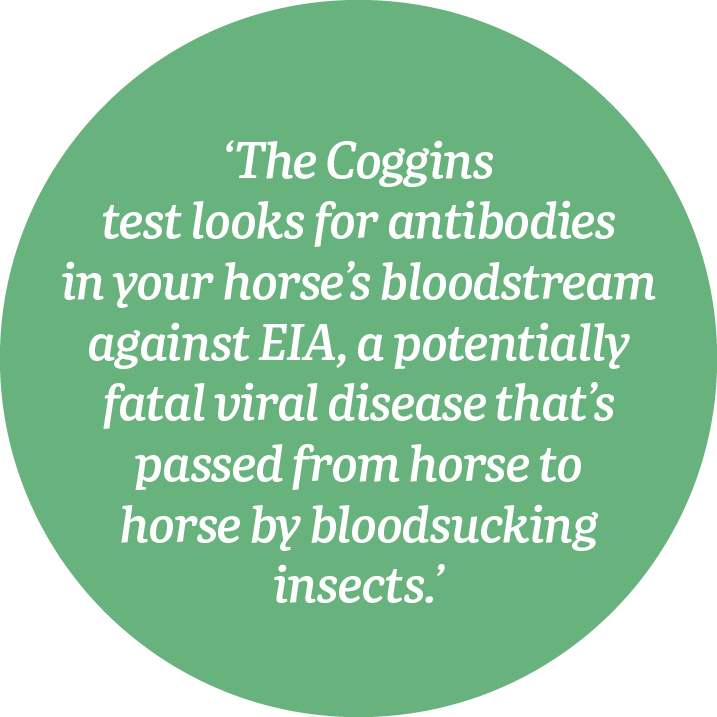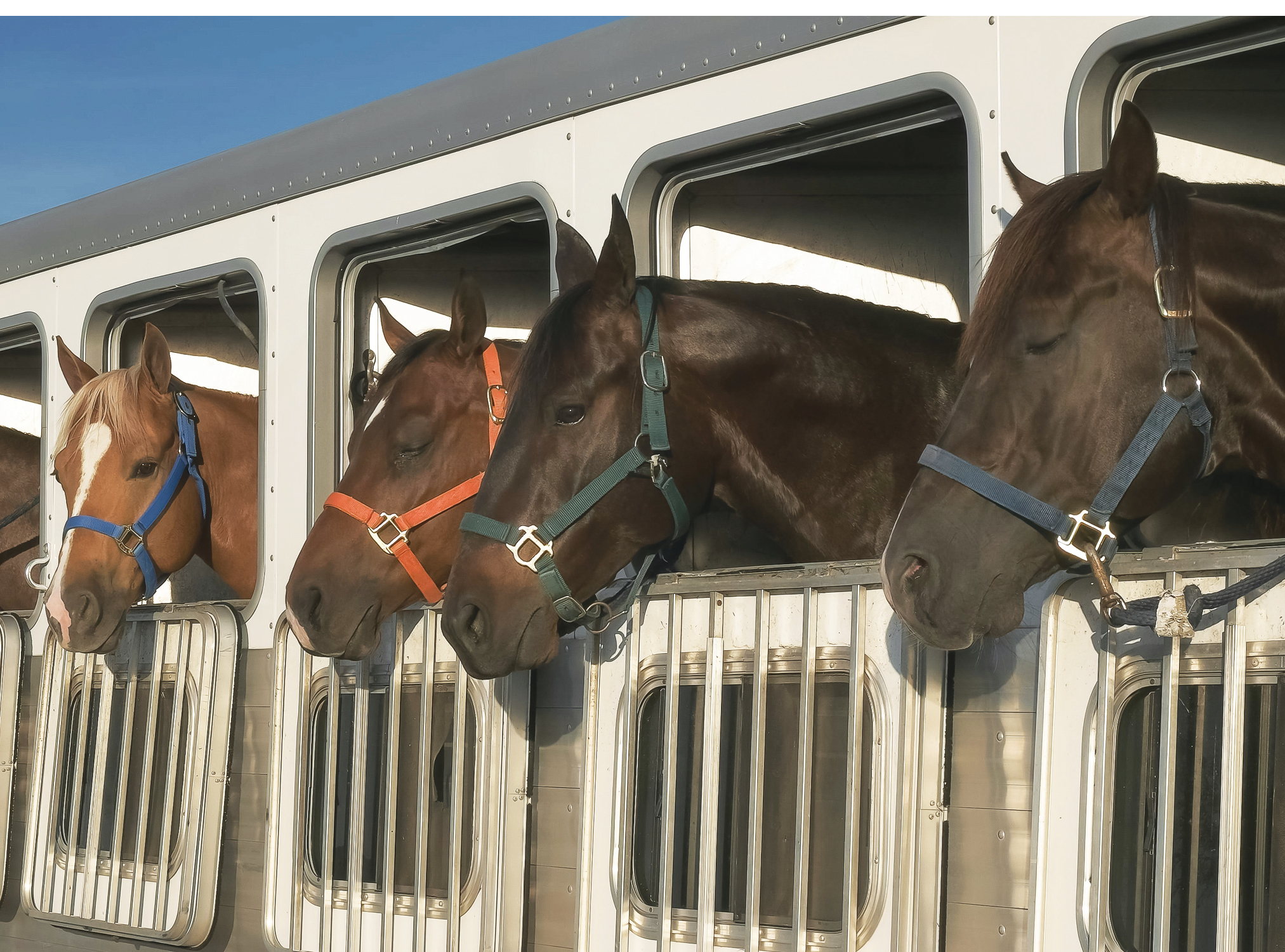I was digging through a box of papers the other day and came across a report I’d written in sixth grade: “EIA: Is Test and Slaughter the Answer?” I still remember writing the report, pondering the dilemma, and looking for solutions. I somehow grasped the importance of controlling the spread of a terrible, fatal disease in horses. That was 1972.
Fast-forward to today. I’ve been a practicing veterinarian for 30 years. And in that 30 years, I’ve never seen a positive Coggins test, the blood test that detects a horse’s antibodies to equine infectious anemia (EIA).
How can that be? Because, in fact, testing and “lifetime quarantine” did prove to be the answer. Does that mean EIA has been eradicated completely? No. But that does mean it’s been pretty well controlled—largely because of mandatory testing required for horses transported across state lines.
Considering the low risk of your horse contracting EIA, you might find yourself frustrated by the requirements for Coggins testing and a veterinary inspection to travel to horse shows, equine events, and trail-riding destinations. It might seem like a waste of time and money to pursue an already-expensive hobby. After all, there’s nothing to prevent your horse from getting sick after the inspection and before you hit the road. And half the time, no one checks your papers anyway.
You might not realize that those health papers serve a bigger purpose than simply “granting you permission” to travel with your horse. In fact, they’re one of the most important tools officials have for eradicating equine diseases, preventing new diseases from gaining a foothold in the country, and tracking and controlling outbreaks.
Here, I’ll answer common questions about equine-travel requirements—not only what they are but also why they matter. In the end, you’ll begin to understand the essential role those requirements play in protecting not only your own horse but also horses everywhere.
Keep your horse’s health paper’s organized in a binder!
Products we feature have been selected by our editorial staff. If you make a purchase using the links included, we may earn a commission. For more information click here.
Q: What is a Coggins test, and why is it required for travel? I’ve had my horse tested every year since I’ve owned him, and it always comes
back negative.
A: The Coggins test looks for antibodies in your horse’s bloodstream against EIA, a potentially fatal viral disease that’s passed from horse to horse by bloodsucking insects. This virus can cause an acute form of the disease with severe signs—including high fever, weakness, depression, and even death—or a chronic form with milder signs that come and go for years. There’s no available treatment, and an infected horse harbors the virus for life. To complicate matters, an infected horse can become an inapparent carrier—meaning that he harbors the virus in his bloodstream, but never shows clinical signs. It’s this invisible carrier state that makes this disease so difficult to control; hence, the testing requirements.
[READ: BINDERS FOR HORSE-PAPER ORGANIZATION]
The incidence of EIA peaked in the 1960s and 70s; 10,371 cases were reported in 1975. The Coggins test was introduced in 1972. The incidence dramatically decreased in the ensuing decades through a program of test and slaughter in some cases or test and mandatory lifetime quarantine of infected horses in others. At its lowest point in 2009, only 37 horses harboring the EIA virus were detected nationwide.
Q: If Coggins testing has been so successful for controlling this disease, why do we still have to do the test? It must be almost gone by now.
A: The 2019 measles outbreak in children is a good example of why this type of thinking is so fatally flawed. When parents stopped vaccinating their children, this fatal childhood disease reared its ugly head. At this writing, 15 states have reported cases of measles. It’s easy to forget how terrible these diseases really are when they’re rarely seen, and it’s easy to become complacent about controlling them.
EIA has been well controlled because of testing. That doesn’t mean it’s disappeared completely. In 2017, the USDA reported that 1,299,683 Coggins tests were performed in the United States with only 80 positive results. If we stop testing altogether, there’s still a small reservoir of horses out there that will allow EIA to rise in prevalence once again—eventually becoming just as widespread as it was in the 1970s.
This risk was demonstrated during the 2018 EIA outbreak in Colorado and nearby states. A single horse was taken across state lines without a Coggins test. This horse turned out to be a carrier. Due to widespread movement of horses in the area, more than 240 horses were exposed to the index case, and more than 100 of those horses traveled to other states—potentially exposing an enormous number of horses. All of this risk could’ve been avoided had the original horse been tested prior to transport.

Q: How does it do any good to get a health certificate for my horse 30 days before I travel with him? He could easily get sick after my vet issues the certificate but before I hit the road.
A: It’s true that getting a Certificate of Veterinary Inspection (or CVI, commonly called a health certificate) prior to travel really doesn’t prevent you from hitting the road with a sick horse. But that’s not really the point of the inspection. In fact, the most important reason for the CVI requirement is to help control infectious-disease outbreaks by providing a way for officials to trace animal movement.
Traceability depends on three factors: identification, location, and time. An official veterinary inspection helps locate individual horses by placing them at a known location at a specific point in time. With this as a starting point, officials can identify horses potentially exposed to a disease as quickly as possible. Once horses are identified, they can be quarantined to help prevent spread of the disease.
The 2011 equine herpesvirus-1 (EHV-1) outbreak that started at the National Cutting Horse Association Western National Championships in Ogden, Utah, is one of the most frightening examples of just how fast and far a disease outbreak can spread. During that outbreak, more than 2,000 horses were exposed to the virus at more than 240 facilities in 19 states and one Canadian province. Identifying and tracking potentially exposed horses quickly was critical, not only to control the outbreak at the time but also to study the patterns of spread and to develop strategies for future outbreaks.
If your horse gets sick, stay home, even if you do have papers. It’s unwise to travel with your horse if he’s spiked a fever or has developed other signs of a potentially transmissible disease, such as a snotty nose, a cough, or diarrhea.
Q: What about an equine passport? I live in a state where I can get a veterinary inspection for my horse at the beginning of the show season that allows me to travel back and forth between several states for six months. How is this helpful?
A: State-to-state requirements do vary. Some require inspection within 10 days of travel, while others allow horses unlimited travel to nearby states for a period of six months. But now you know that the purpose of these inspections is more about monitoring animal movement than preventing sick horses from traveling.
For the purposes of traceability, six-month equine passports are still reported to officials as soon as they’re issued, which can help shorten the time it takes to identify a horse exposed to an outbreak and help limit spread. Owners are also required to submit records at the end of the six-month period, which allows officials to examine animal movement to help understand future outbreaks. If you’re the holder of a six-month passport, don’t overlook this important step. Follow up with reporting on your horse’s movement.

chris/istockphoto.com
Q: I used to travel all over with my horse and nobody ever asked for paperwork. Why do the rules seem to be getting so much stricter?
A: One reason is that the scope of equine travel has shown staggering growth in recent years. International travel is the most important factor when it comes to the global spread of infectious disease. In 1997, 517 international equine events were recorded. This number increased to more than 3,400 by 2016. Widespread outbreaks are becoming all too common among these equine travelers.
Even if your horse isn’t an international traveler, global increase in horse movement still puts him at increased risk for exposure to disease. Officials are working hard to develop systems to minimize these risks.
Another risk factor: The United States horse population is one of the most naïve populations in the world when it comes to many foreign diseases. An example is equine piroplasmosis, a tick-borne disease that causes a wide range of nonspecific signs, including fever, lethargy, weakness, or even death. Although this disease is common in some parts of the world, it’s still considered a foreign animal disease in the U.S.; there are strict testing requirements before entry into the country is allowed. Similar to EIA, piroplasmosis is carried in the blood of horses that often show no signs at all; testing is the only way to identify an infected horse.
Piroplasmosis has an interesting history in the U.S. In the early 1960s, it was identified in Florida. In 1962, a statewide eradication effort was initiated; in 1988, the U.S. was declared piroplasmosis-free. The disease is currently believed to be present in a small area of Texas and has been seen sporadically elsewhere but still hasn’t spread widely throughout the country.
Q: Will piroplasmosis testing eventually be required for all domestic travel just like Coggins testing is?
A: Possibly. Piroplasmosis testing is currently required for any horse coming into the U.S. from any other country except for Canada and Iceland, whether it’s for permanent import or a short-term stay. Piroplasmosis-positive horses that come to the U.S. for international competition may be granted a waiver to compete and are required to be kept in isolated facilities that are overseen by the USDA. Domestically, some states and venues already require piroplasmosis testing; it remains to be seen whether this requirement will become more common as officials work to prevent a foreign disease from becoming endemic in the U.S.
Q: Are tests and veterinary inspections required for equine travel just a nuisance—or are they a necessity?
A: We’ve seen that testing and inspection requirements play a role in eradicating diseases, as illustrated by: (1) the Coggins test’s role in controlling EIA; (2) controlling disease outbreaks through veterinary inspections that aid with traceability; and (3) preventing the introduction and spread of new diseases, such as piroplasmosis, through testing. All of these requirements may seem like a nuisance, but they really do play an important role in protecting not only your own horse’s health but also to help prevent and control spread of disease to horses everywhere.






